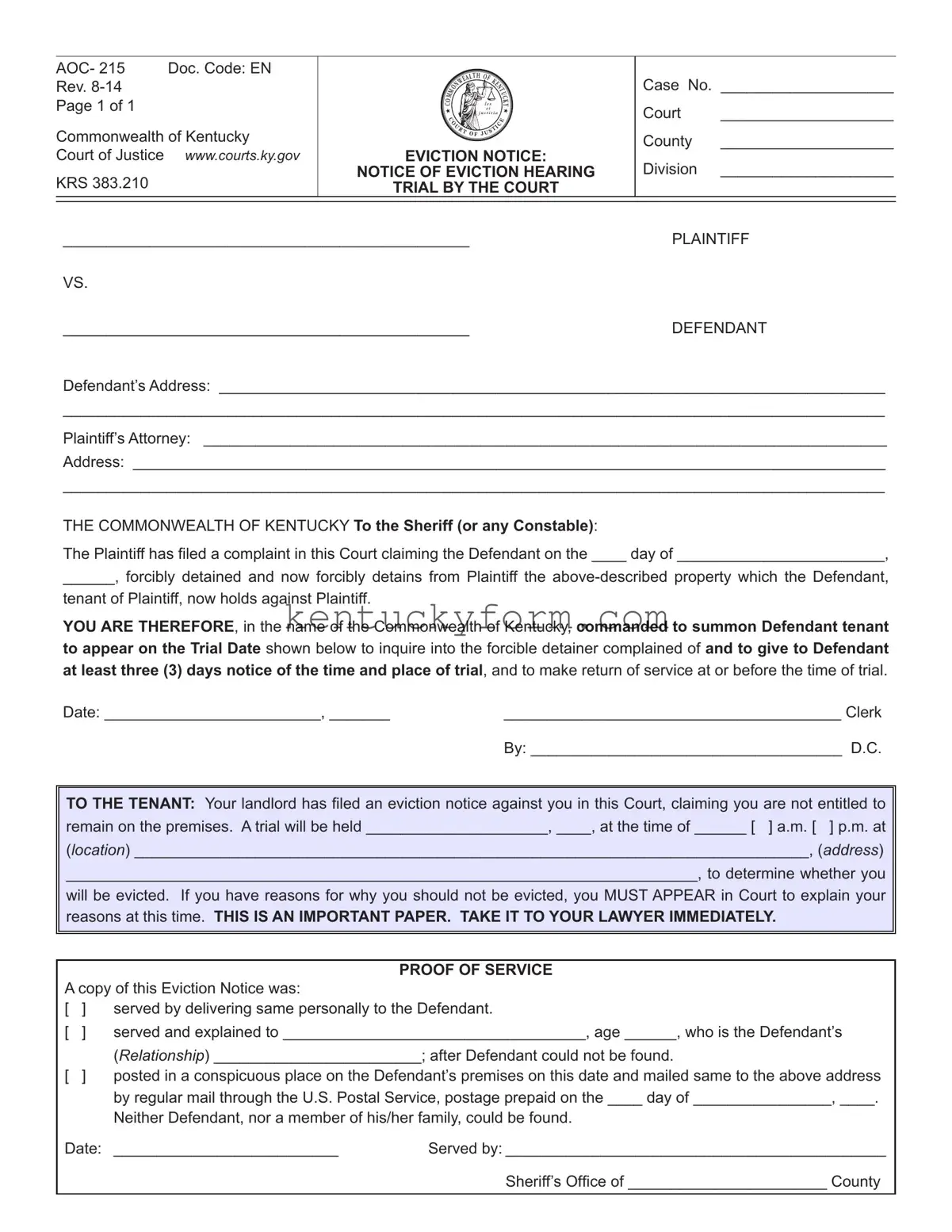The Kentucky AOC-215 form, utilized for issuing eviction notices, bears resemblance to the Notice to Quit form, commonly used across various jurisdictions to commence eviction proceedings. Both documents serve as a preliminary step in the eviction process, providing tenants with official notification of the landlord's intention to reclaim possession of the property. They specify the reasons for eviction, detail the property involved, and offer the tenant a defined period to either remedy the violation or vacate the premises. The purpose of these documents is fundamentally to ensure that tenants are given fair warning and an opportunity to respond before any legal action is intensified.
Similar to an Unlawful Detainer Notice, the Kentucky AOC-215 form is critical in the eviction litigation process. An Unlawful Detainer Notice is typically the next step after a Notice to Quit has been ignored, and it formally begins the court proceedings against a tenant for the recovery of property and past due rents. Both documents are legal tools that landlords must properly serve to move forward with evictions. They share the objective of facilitating a court's examination of an alleged improper possession, allowing for an orderly resolution through a legal hearing.
The Summons and Complaint in Eviction form, another integral component of eviction proceedings, closely relates to the AOC-215 form in its function and structure. This document formally initiates the eviction lawsuit, providing detailed information about the legal action, including the parties involved, the basis of the eviction claim, and the court where the action is filed. Like the AOC-215, it also serves to notify the tenant of their obligation to appear in court and respond to the lawsuit, emphasizing the legal seriousness of the situation.
The Rent Demand Letter shares similarities with the Kentucky AOC-215 form, although it precedes formal legal action. This letter is a precursor in the eviction process, demanding payment of overdue rent and warning of potential eviction if the issue is not resolved. Both documents are centered around the notification concept, aiming to inform tenants of the landlord's intentions and the consequences of non-compliance. They provide tenants a chance to rectify the situation before it escalates to a court hearing.
A Lease Termination Notice is related to the AOC-215 form as it similarly communicates the ending of a rental agreement but can encompass broader reasons beyond non-payment or lease violations that might lead to eviction. This notice is often used in situations where a landlord wishes to reclaim the property for personal reasons or when a lease term concludes. Both documents ensure landlords formally notify tenants of significant changes to their tenancy status, requiring legal and procedural correctness to prevent disputes.
The Property Reclamation Notice is akin to the Kentucky AOC-215 form in that it is employed by landlords wishing to regain possession of their property. While the AOC-215 form specifically relates to eviction proceedings for reasons outlined in the notice, a Property Reclamation Notice might be used in a variety of other contexts, such as after a property has been abandoned by the tenant. Despite their different contexts, both documents serve the primary purpose of facilitating the recovery of property by the rightful owner under the law.
Another document that aligns with the intent of the Kentucky AOC-215 form is the Tenant's Answer to Complaint for Unlawful Detainer. This legal document is the tenant's formal response to the claims made in an eviction proceeding, such as those initiated by the AOC-215. While one initiates the legal process based on allegations of wrongful detention of property, the other allows the tenant to legally defend against these allegations. Together, they ensure both parties' rights and positions are considered during eviction litigation.
Lastly, the Judgment for Eviction Notice, resulting from an eviction trial, complements the AOC-215 form by concluding the eviction process it begins. After a judge reviews the evidence and hears both parties' arguments, this document officially determines whether the tenant must vacate the disputed premises. While the AOC-215 form advises of a scheduled hearing, the Judgment for Eviction crystallizes the court's decision, ultimately enforcing or dismissing the eviction. Both are pivotal in the legal journey from eviction notice to resolution.

